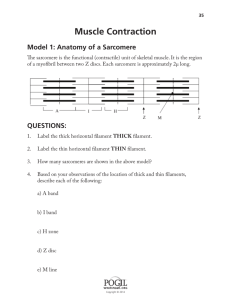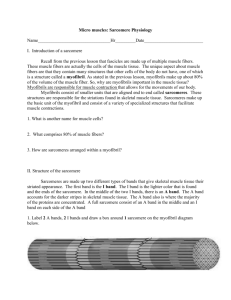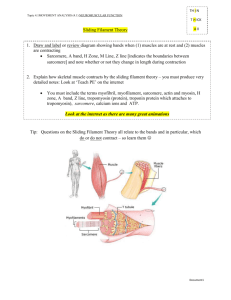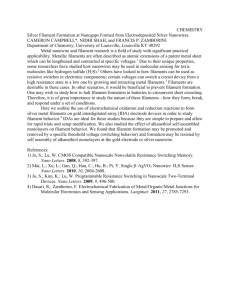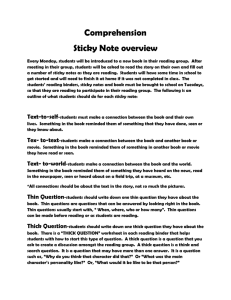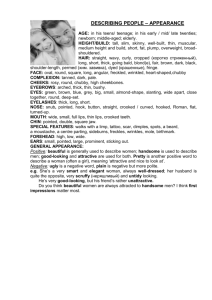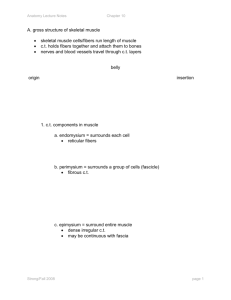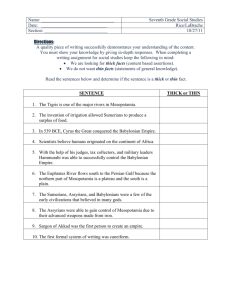Muscle Contraction Instructor's Guide
advertisement
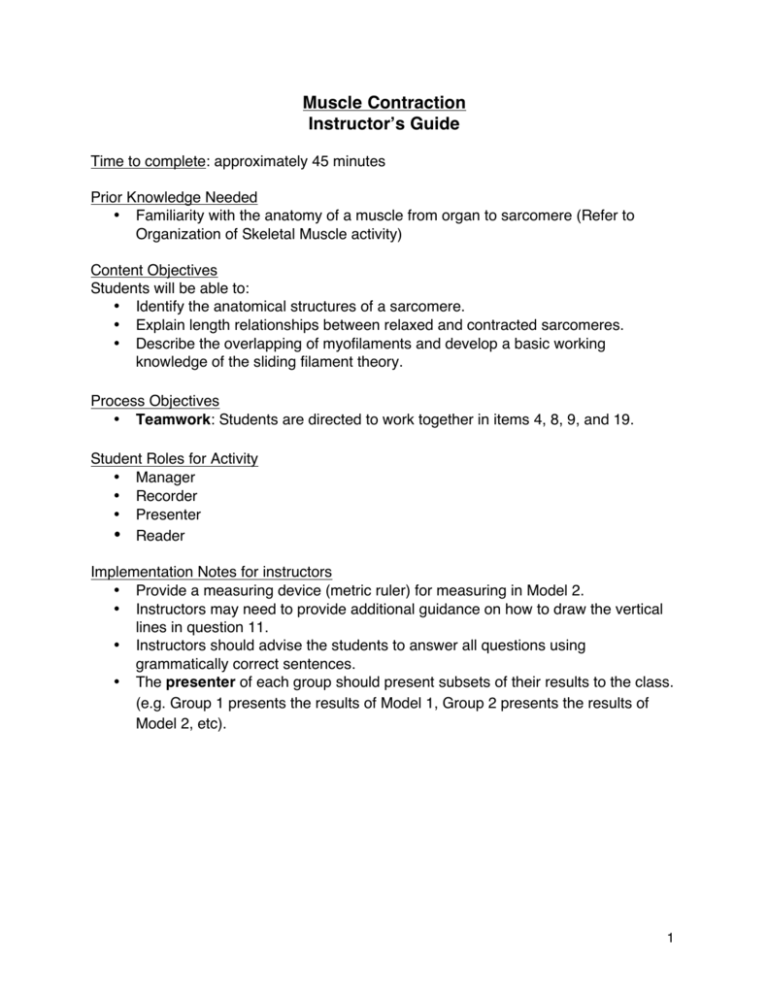
Muscle Contraction Instructor’s Guide Time to complete: approximately 45 minutes Prior Knowledge Needed • Familiarity with the anatomy of a muscle from organ to sarcomere (Refer to Organization of Skeletal Muscle activity) Content Objectives Students will be able to: • Identify the anatomical structures of a sarcomere. • Explain length relationships between relaxed and contracted sarcomeres. • Describe the overlapping of myofilaments and develop a basic working knowledge of the sliding filament theory. Process Objectives • Teamwork: Students are directed to work together in items 4, 8, 9, and 19. Student Roles for Activity • Manager • Recorder • Presenter • Reader Implementation Notes for instructors • Provide a measuring device (metric ruler) for measuring in Model 2. • Instructors may need to provide additional guidance on how to draw the vertical lines in question 11. • Instructors should advise the students to answer all questions using grammatically correct sentences. • The presenter of each group should present subsets of their results to the class. (e.g. Group 1 presents the results of Model 1, Group 2 presents the results of Model 2, etc). 1 Muscle Contraction Model 1: Anatomy of a Sarcomere The sarcomere is the functional (contractile) unit of skeletal muscle. It is the region of a myofibril between two Z discs. Each sarcomere is approximately 2µ long. Thick filament A I Thin filament H Z M Z QUESTIONS: 1. Label the thick horizontal filament THICK filament. 2. Label the thin horizontal filament THIN filament. 3. How many sarcomeres are shown in the above model? 4. Based on your observations of the location of thick and thin filaments, describe each of the following: (answers may vary among groups). a) A band- extends the length of the thick filament and includes a portion of the thin filament b) I band- area between the ends of the thick filaments; contains only thin filaments c) H zone- areas between the ends of the thin filaments; contains only a portion of the thick filaments d) Z disc- vertical line at each end of the sarcomere located in the middle of the I band e) M line- vertical line in the middle of the H zone that connects the thick filaments together 5. Using complete grammatically correct sentences, describe how the H zone differs from the A band. 2 The H zone is located in the middle of the A band. The H zone contains only thick filaments. The A band consists of thick and thin filaments. The H zone is a subset of the A band 6. How many sarcomeres do you think are in a muscle cell found in your quadriceps? Many thousands to millions 7. Do you think you would have more or fewer sarcomeres in an eye muscle? Fewer, eye muscles are smaller Model 2: Comparing Relaxed and Contracted Sarcomeres Figure 1. Relaxed sarcomeres. Figure 2. Contracted sarcomeres. QUESTIONS: 8. In Figures 1 and 2 above, label the A-bands, I-bands, and H-zones. Measure and record the lengths (in mm) of these structures and the thick and thin filaments in the chart below: Thick filament Did the length change between Figures 1 and 2? (Y/N) N Thin filament N A band N I band Y Structure Length in Relaxed Sarcomere (mm) Length in Contracted Sarcomere (mm) 3 H zone Y Sarcomere Y 9. Discuss the data from the table in Question 8 with your group and describe what happens to thick and thin filaments when muscles contract: A sarcomere shortens when the thin filaments and thick filament overlap to a greater extent. The filaments do not shorten, but overlap, causing a shortening of the sarcomere as a whole. 10. As a group, examine the diagram in Model 2. Why is there a limit to the amount of shortening that can occur in a sarcomere during muscle contraction? Answers may vary. Possible answer: Depending upon the length of the thin filaments, there is a limit to the amount of overlapping that can occur between the thick and thin filaments. Also, the Z discs may run into the ends of the thick filaments and not be able to shorten any further. 4 Model 3: Cross Sections Through a Sarcomere Model 3 shows cross-sections of a sarcomere that show the filaments at various locations within a sarcomere. Thin Fig. A Thick Fig. B Thin Thick Fig. C QUESTIONS: 11. Label the thick and thin filaments in Figs. A, B, and C above. 12. There are three sarcomeres shown in the diagram below. Sarcomere 1 A Sarcomere 2 B Sarcomere 3 C a) In Sarcomere 1, identify the location within the sarcomere of the cross section indicated by Figure A in Model 3. Draw a vertical line and label it A. b) In Sarcomere 2, identify the location within the sarcomere of the cross section indicated by Figure B in Model 3. Draw a vertical line and label it B. 5 c) In Sarcomere 3, identify the location within the sarcomere of the cross section indicated by Figure C in Model 3. Draw a vertical line and label it C. 13. Which of the figures (A, B, or C) represents a cross section in the H zone? B 14. Which of the figures (A, B, or C) represents a cross section in the I band? A 15. Which of the figures (A, B, or C) represents a cross section in the ends of the A band? C 16. On the figure below, shade in the area of the A band. Then identify the location of the I band and label it. I 17. When viewing skeletal muscle through a microscope, you can easily see the dark and light striations of the muscle fiber. Compare the shading in the diagram in Question 15 an in the photograph of muscle fiber as seen through a microscope below. What forms the dark and light bands? The dark bands consist of the A band which has the thick filaments and portions of the thin filaments. The light bands consist of the thin filaments of the I band. A Band I Band Z disc Sarcomere e Courtesy of: LUMEN - Loyola University Medical Education Network 6 18. On the photograph above, label the A band, I band, Z disc, and a sarcomere. 19. The sliding filament theory is used to explain the physiology of skeletal muscle contraction. On your own, using what you have learned from this activity, write your own description of what the sliding filament theory states. Answers will vary. 20. Next, discuss your predictions with your group members and develop a definition of the sliding filament theory with regard to thick and thin filaments. (Use grammatically correct sentences). Answers will vary. The correct answer should be similar to the following: When a skeletal muscle contracts, thin filaments slide past the thick filaments. In this process, the H bands and I bands get smaller; the zones of overlap get larger, the Z discs move closer together, and the width of the A band remains constant. This explanation is known as the sliding filament theory (Martini and Ober, 2011). Source: Martini, F.H. and Ober, W.C. 2011. Visual Anatomy and Physiology. Benjamin Cummings, Boston, pp 287. 7
